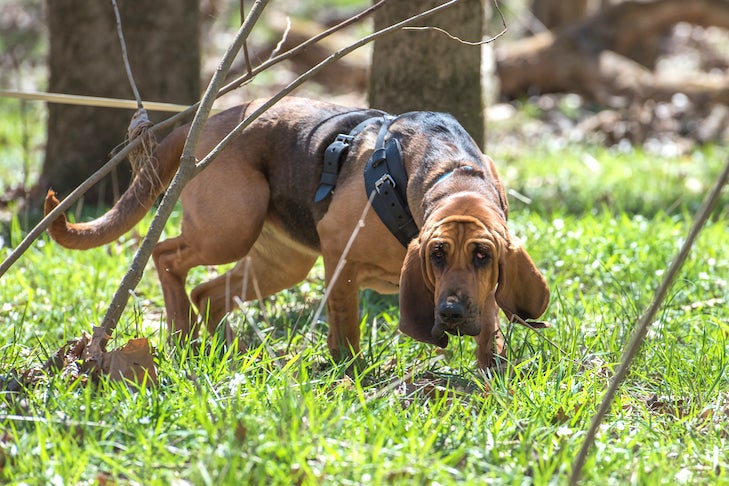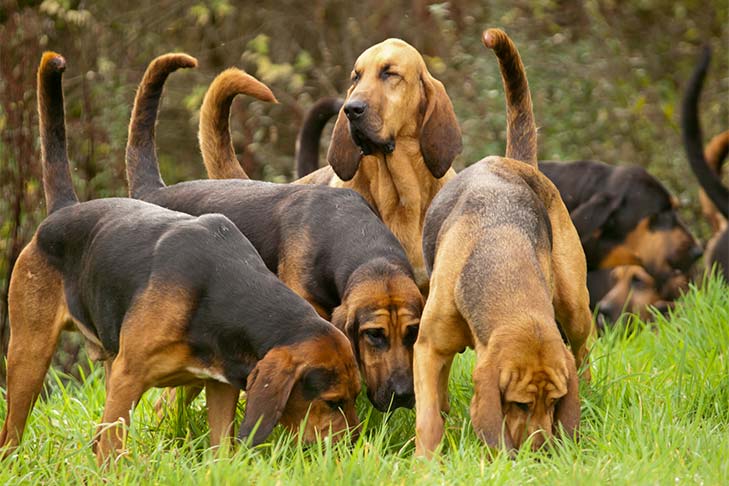Though it’s been around in one form or another for hundreds of years, Mantrailing is still a helpful tool when hunting for missing persons, despite technological advances. Mantrailing dogs continue to prove their worth locating criminals, missing children, and people with Alzheimer’s, among others. In fact, these trained dogs’ trailing skills are so reliable that court proceedings accept their findings as evidence.
In recent years, the activity has been growing in popularity as a recreational and competitive dog sport. Increasingly, breeds other than Bloodhounds are also putting their scenting and trailing skills to the test. After all, a dog’s sense of smell is at least 40 times more sensitive than humans.
What Is Mantrailing?
Dogs learn to seek out an individual’s scent from skin rafts (dead or dying cells) that naturally shed from the body. Before the exercise begins, the dog will sniff an article that the person has touched. They then follow the trail on a long leash attached to a harness, aiming to locate that person.
Terri Heck and her husband Jim run Summit Search and Rescue in Pennsylvania, and they’re also Mantrailing Judges for the American Bloodhound Club (ABC). They currently have two Bloodhounds, Briggs and Stratton, on their team. Seven-year-old seasoned detective K9 Briggs has worked hundreds of cases locating missing and wanted individuals. “The solid indications she has provided have led to numerous search warrants, arrests, and convictions,” explains Terri.
Experienced dogs and handlers can follow scent trails that are up to two days old, but seriously skilled Bloodhounds have been known to follow trails weeks after the individual has passed through the area.
Dogs used for Mantrailing in the police or search and rescue teams are in constant training. They’ll work a variety of aged and new trails, be out in all weather, and negotiate differing terrains and environments.
Whether you are a professional Mantrailer or just taking part as a hobby, the training should always be fun for your dog. If you want them to stay focused and motivated, they need to find the activity rewarding. What constitutes rewarding will vary depending on the dog — some love food or treats, while others will work for toys.

Why Is the Bloodhound Such a Champion Mantrailer?
Bloodhounds are the ultimate Mantrailers. Most breeds have, on average, 100 million scent receptors in their noses — Bloodhounds have at least double that number.
They’re also known for being persistent, relentless, and somewhat stubborn. Their long, droopy ears and jowly, wrinkled faces trap scents as they have their face down sniffing out the trail. With their long, muscular necks and powerful bodies, these dogs have the stamina needed to handle long days out in challenging terrain.
Jan Rothwell, who hilariously describes herself as the “dope at the end of the rope,” has 40 years of Bloodhound experience and is another Mantrailing Judge for the ABC. She describes the breed as being “a nose with a dog attached,” and she is an advocate for trailing with them because it’s “an activity they were bred for and that they truly love doing.”
Can Dogs Other Than Bloodhounds Excel in Mantrailing?
It’s not just Bloodhounds that take part in professional Mantrailing. Other hunting breeds like Pointers, and intelligent, driven dogs like the Belgian Malinois and German Shepherd are often employed for the job too.
For owners wanting to try Mantrailing as a hobby, not every dog will take to it. But those that do enjoy it find the sport to be a fantastic way to harness their innate drive to engage their nose.
What Benefits Can This Sport Offer You and Your Dog?
Unlike some other dog sports, Mantrailing is suitable for young puppies, elderly, blind, deaf, and tripawd dogs. It’s a perfect low-impact activity.
Reactive dogs and those that are nervous or fearful can take part too. They don’t have to work near other dogs or people, and it’s possible to control the environment. This helps to build confidence and allows them a great deal of autonomy. A dog that has spent the day following a trail will come home tired. They’ll feel mentally and physically stimulated, without having been over-aroused.

Mantrailing relies a lot on the trust between the dog and handler. It’s a great way to strengthen the bond you have. Rothwell offers some sage advice for the novice trailer. “Don’t interfere with your dog’s ability,” she says. “Your job is to learn what your dog is telling you with the head, tail, and other cues. Keep an open mind and be a worthy partner.”
How Does Mantraling Differ from AKC Tracking?
Mantrailing is often referred to as tracking, but this is actually a different type of scent work. AKC tracking competitions require the dog to follow a recent trail and find articles along the way. The track is usually one to five hours old, isn’t longer than 1,000 yards, and there’s no person to find at the end of it.
Competitive Mantrailing, on the other hand, is all about following the individual’s scent from the start of the trail to the end — with the goal of finding that person. Trails are much older, up to 36 hours at the most advanced level, and can vary in their difficulty. The most challenging trails will put the dogs in congested areas and use additional runners to contaminate the scent.
How to Get Involved in Mantrailing
Mantrailing for hobby participants hasn’t yet taken off in the United States in the way it has in Europe, but interest is growing.
The American Bloodhound Club has three recognized trailing titles that dogs and handlers can work toward. Participants just need AKC registration and must have completed the Event Entry Certification Test (EECT). These titles are, of course, only open to Bloodhounds.
For other dogs, it’s still possible to take part in Mantrailing events. A good starting point would be to contact the American Mantrailing Police and Work Dog Association (AMPWDA). Tony Keith is a Master Instructor for the Association. He started his Mantrailing career in 1991 when he was assigned to the K9 Team for the Indiana Department of Correction. Since then, he has participated in more than 500 manhunts.
“The AMPWDA holds free-to-the-public training one Saturday each month in Indiana,” Tony explains. “We are a member-based organization and host two national seminars (spring and fall) in Indiana and several state workshops across America.”
And what are his top tips when it comes to trailing? “Trust your dog, be patient, make every training session enjoyable, and to keep a log or journal.”

